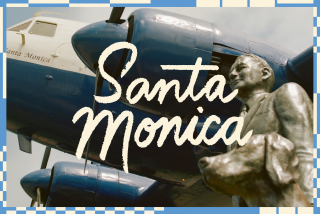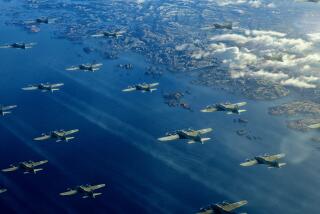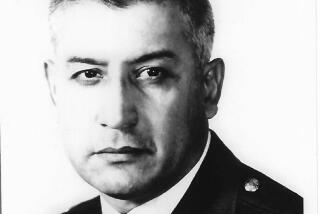Pilots Say Flying Was No Breeze
Arthur Guy, a Municipal Court judge in Fullerton, was one of nearly 50 blimp pilots stationed at the Santa Ana Naval Air Station during the 1940s. Drawn to what a friend had told him was “the latest in military technology,” he spent most of the war with a crew of nine in a cabin of a 290-foot-long airship off the Southern California coast.
“A lot of people seem to think it was easy to fly those blimps,” Guy said. “But it really wasn’t quite that simple. We did more than float around up there.”
Today, those blimps are historical afterthoughts. But in the company of Guy and his old friend Hugh Tolford--a fellow blimp pilot who now lives in Van Nuys--the era is quite easily revived. All one has to do is say the word blimp and then stand back.
“Sometimes people don’t believe me when I tell them what we did,” Tolford said at his home, after carting out some boxes full of records and photographs. “I always end up attracting little crowds at parties. It’s a pretty good conversation piece.”
Guy and Tolford, both 72, spent a good part of their 20s getting up before dawn, driving to the Santa Ana Lighter Than Air Facilities and climbing into matching pairs of blimps. While they checked their cabins and welcomed their crews, the masts to which the blimps were moored would be towed out of the hangars and pulled into the wind. Motors would be revved and readied, and the blimps would move forward and up.
From then until long after dark, these helium-filled airships served as sentinels and guides, guarding against the threat of Japanese attack.
The invasions, of course, never came. But while they waited, Guy and Tolford mastered a skill that is now about as common as flying on a carpet.
“There was definitely an art to it,” said Tolford, still proud. “You learned to corkscrew down through the wind. You learned a huge amount about the wind.”
You also learned some strange facts. For instance, both Tolford and Guy can tell you that chickens look at blimps and quickly panic. On takeoffs at the Santa Ana air base, the shadows caused local hens to run screaming to the corners of their cages, and then to lay blood-filled eggs. Farmers complained to the local papers, and the takeoff patterns were changed.
Fishing, on the other hand, was easy. Tolford said pilots regularly called local fishermen to tell them where the schools were running. One year, the local sardine catch rose by several thousand pounds as a result.
At sea the days were long, though not too quiet. Because the long, thin cabins were wedged between the motors on the blimp, the roar was continuous and deafening. And because the controls were largely manual, fighting off the winds could be a struggle.
“The steering mechanism was a large wooden wheel attached to the pilot’s seat like one of the wheels on a wheelchair,” Guy recalls. “At most, a pilot could hold that wheel for two hours before he’d be relieved.”
Now and then the crew made silly little mistakes. Guy remembers fearing for his job when a hung-over crewman dropped the contents of his on-board toilet over an aircraft carrier.
“They were expecting the Sunday paper,” he said. “I never lived it down.”
But Tolford and Guy were pipsqueaks compared to the base’s most famous pilot, known to everyone as Ace Culbertson. Culbertson, a Stanford boy, was repeatedly decorated for his air-to-sea rescues and known for his navigating skill. But he seems to be best remembered for the time he started a fire on the crest of Santa Rosa Island while shooting at boars with his blimp’s machine gun.
“The machine guns on these blimps carried flares,” Guy said. “We all lost touch with Culbertson after the war. There’s a rumor he moved to Mexico and joined the air force there. I don’t suppose anyone knows.”
And some mistakes were lethal. Tolford, who served as the unit’s historian and photographer, remembers that the crew of one blimp was killed when its ship crashed into Catalina Island. A few months later, a 10-man ground crew holding down a Santa Ana blimp was electrocuted when the blimp hit a power line. And Guy recalls that all but one of the nine members of his crew were killed in an explosion while he was on leave.
“That was horrible,” he said. “The blimp was falling through its gasoline fumes, and someone turned a generator on.”
In the background, always, was the war. Both Guy and Tolford recall chasing off repeatedly to investigate ominous blips on the radar, only to find a lost fisherman, or nothing at all. At times like those, Tolford said, it bothered him that others were fighting and dying while “we were sitting fat and happy.”
“I think we all felt a certain amount of guilt,” he said.
But they also felt some pride. Both are quick to point out that German U-boat attacks disappeared on the Eastern Seaboard when blimps came into use. The fact that blimps were there from the start may have served as a deterrent in the West.
“I think we did our part,” Tolford said. “I think they were afraid of us.”
More to Read
Sign up for The Wild
We’ll help you find the best places to hike, bike and run, as well as the perfect silent spots for meditation and yoga.
You may occasionally receive promotional content from the Los Angeles Times.






